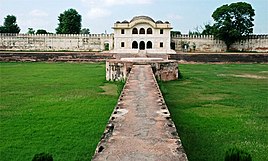Fatehgarh Sahib | |
|---|---|
City | |
Clockwise from top: Gurdwara Fatehgarh Sahib, Rauza Sharif, Aam Khas Bagh, Jahaz Haveli, Khanda Museum. | |
| Coordinates: 30°38′50″N 76°23′35″E / 30.64722°N 76.39306°E | |
| Country | |
| State | Punjab |
| District | Fatehgarh Sahib |
| Named for | Baba Fateh Singh, son of Guru Gobind Singh |
| Elevation | 246 m (807 ft) |
| Population | |
• Total | 50,788 |
| Languages Punjabi | |
| • Official | Punjabi |
| Time zone | UTC+5:30 (IST) |
| PIN | 140406,140407 |
| Telephone code | +91-1763 |
| Vehicle registration | PB-23 |
| Website | www |
| [1] | |
Fatehgarh Sahib (Punjabi pronunciation: [fə.t̪éː.gə́ɽᵊ sä́ːbᵊ]) is a city and a sacred pilgrimage site of Sikhism in the north west Indian state of Punjab.[1][2] It is the headquarters of Fatehgarh Sahib district, located about 5 kilometres (3.1 mi) north of Sirhind. Fatehgarh Sahib is named after Fateh Singh, the 7-year-old son of Guru Gobind Singh, who was seized and buried alive, along with his 9-year-old brother Zoravar Singh, by the Mughals under the orders of governor Wazir Khan during the ongoing Mughal-Sikh wars of the early 18th century.[1][2] The town experienced major historical events after the martyrdom of the sons in 1705, with frequent changes of control between the Sikhs and Mughals.[1][3]
The town features historic Gurdwaras, including the underground Bhora Sahib marking the location where the two boys refused to convert to Islam and fearlessly accepted being bricked alive.[1][4] In contemporary times, the town is the site of educational institutions such as the SGPC run Guru Granth Sahib University and Baba Banda Singh Bahadur Engineering College.[5]
- ^ a b c d Gurmukh Singh (2009), Fatehgarh Sahib, Encyclopedia of Sikhism, Editor in Chief: Harbans Singh, Punjab University
- ^ a b W. H. McLeod (2009). The A to Z of Sikhism. Scarecrow. p. 65. ISBN 978-0-8108-6344-6.
- ^ H. S. Singha (2000). The Encyclopedia of Sikhism (over 1000 Entries). Hemkunt Press. pp. 186–187. ISBN 978-81-7010-301-1.
- ^ Harish Jain (2003). The Making of Punjab. Unistar. p. 289.
- ^ Pashaura Singh; Louis E. Fenech (2014). The Oxford Handbook of Sikh Studies. Oxford University Press. p. 555. ISBN 978-0-19-100412-4.






